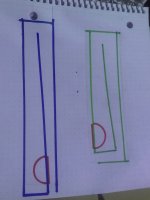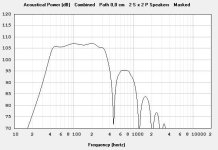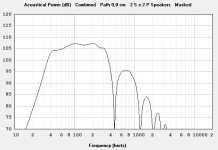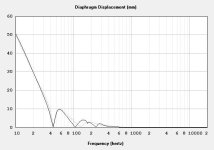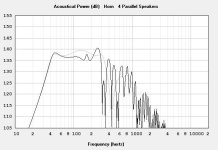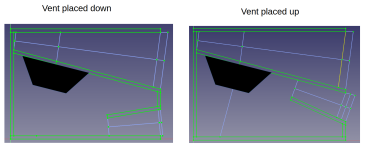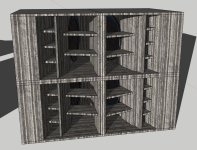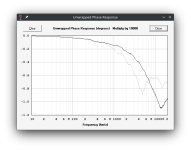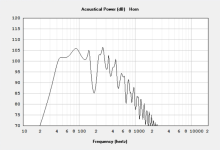No it’s not, It’s a qw resonator.
It's that too. However, TH is a gigantic positive flare port from throat to mouth with the driver mounted inside the port.
A TL is normally a gigantic negative flare port from throat to mouth with the driver mounted outside the port.
All these items do the same thing, increase SPL. ALL OF THEM are 4th order devices or part of a 4th other device if your lungs are the sealed chamber and your diaphragm is the driver.
I don’t think blue is gaining any ‘SPL’ on green? I’m sure you’d notice this if you cutout the exit area around the driver on your tapped pipe as wellHow about less cone movement per a given voltage vs sealed and BR enclosures.
Lower distortion is your magic.
Combining the front and back wave of the driver is your SPL.
Attachments
Well I can build many boxes, they just can't exceed 45x65x70cm, which puts a single right around 200LEfficient and low = >300L.
What F3 do you want?
What dB do you want at 2.83 volts?
Here is my final iteration, I will get the saw out today. 106db from 45 to 300hz @ 2.83v seems pretty good for a 800L system 🙂
I also added a low tune spl chart. This has one of the four ports plugged.
Attachments
Still the B&C 15NDL76
It's not too expensive, and gets a smoother response than other drivers I have simmed.
The more expensive B&C drivers have more pmax and xmax, but the response is more spikey, and since I will be running on battery, I probably won't run more than 500W
The driver can however no longer be installed via the horn, as I increased the compression ratio. Oh well.
It's not too expensive, and gets a smoother response than other drivers I have simmed.
The more expensive B&C drivers have more pmax and xmax, but the response is more spikey, and since I will be running on battery, I probably won't run more than 500W
The driver can however no longer be installed via the horn, as I increased the compression ratio. Oh well.
I guess it will work right ,and besides that manifold is not that complex, if you don't like how it sound or measure in REW, just remove the driver and recycle it in other box .
I don’t think blue is gaining any ‘SPL’ on green?
That is true. Blue will have less distortion and no need for a grill cover.
I just realized you made Blue bigger than Green. Sounds like "The Incredible Hulk" movie. Make the enclosures equal in size with the same throats and mouths.

So the name of this thread is "would a manifold/mtb be better than a tapped horn"
So I decided to compare Martinson's really nice Tham 15 design, with this Manifold design, as they are the same volume. It seems output and efficiency, Tham is slightly better under 100hz, but from 150hz up, the Tham seems unusable, where the Manifold seems decent up to 300hz. Tham however seems to have a slightly better displacement from 60-120hz.
Tham black line, Manifold grey line.
I used Martinsson's values for hornresp input.
So I decided to compare Martinson's really nice Tham 15 design, with this Manifold design, as they are the same volume. It seems output and efficiency, Tham is slightly better under 100hz, but from 150hz up, the Tham seems unusable, where the Manifold seems decent up to 300hz. Tham however seems to have a slightly better displacement from 60-120hz.
Tham black line, Manifold grey line.
I used Martinsson's values for hornresp input.
Attachments
It seems output and efficiency, Tham is slightly better under 100hz, but from 150hz up, the Tham seems unusable, where the Manifold seems decent up to 300hz. Tham however seems to have a slightly better displacement from 60-120hz.
Well, it's supposed to be a SUBwoofer. Who actually listens to a SUBwoofer at >150hz...and that's even too high.
Anything that prevents those 1/4 wave resonances up top is ‘better’, or you’ll be ‘listening’ to your ‘subwoofer’ up there weather you want to or not 😝
Is wider useable range not always a good thing? You can always cross at 100hz if you want to. Do you think it will sound bad over 150hz? Or do you just not see the point in going that high? I find lots of mids run into excursion issues, when run at full power down to 100hz. Crossing higher can often remedy that.Well, it's supposed to be a SUBwoofer. Who actually listens to a SUBwoofer at >150hz...and that's even too high.
Tham is slightly better under 100hz
Probably with some small tuning you could recover that small difference in SPL.
As a pure exercise, try to increase S2 from loudspeaker wizard keeping all the other parameters the same, probably you will see:
Improved lower range => Worse upper range.
Reduced compression ratio => increase diaphragm displacement.
With automation tools available with freecad you could run some design changes considering also other parameters in order to find the best trade off for your case and make the final comparison and judgment with THAM.
I used your Manifold 2 template with the improved cooling port. Thanks. Your tool is great 🙂In addition, probably, repositioning the vent can improve the cooling for the manifold design, check attached image.
Attachments
That's what she said ! 🤣Your tool is great 🙂
Is wider useable range not always a good thing? You can always cross at 100hz if you want to. Do you think it will sound bad over 150hz? Or do you just not see the point in going that high? I find lots of mids run into excursion issues, when run at full power down to 100hz. Crossing higher can often remedy that.
Yes, you are right and other than wider SPL that sometimes don't tell all the history, you can compare the unwrapped phase response with THAM, probably THAM will present stepper phase response, so Manifold and others 6th order parallel design might be "easier" to crossover with tops. In this case wider range can also means more "places" to find the better slop to do the crossover with tops.
Pronounced SPL around 120Hz can improve a lot the kick feeling due to chest resonance around that spot.
Martinsson who make THAM layout more famous also created the ROAR design, if you check it's SPL response you will see similar pronouncement at different spot for 15", but ROAR has a vary narrow response that I don't like. He says ROAR design is very tactile and punchy. It's subjective, but looking to the graphics we can see where the differences are and do your own judgment.
https://www.martinsson.cc/blog/index.php?m=03&y=17&entry=entry170302-172317
Attachments
- Home
- Loudspeakers
- Subwoofers
- Case for Discussion - Would a Single driver Manifold/MTB be better than Tapped Horn?
